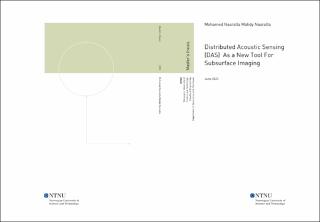| dc.contributor.advisor | Arntsen, Børge | |
| dc.contributor.author | Nasralla, Mohamed | |
| dc.date.accessioned | 2022-11-29T18:19:42Z | |
| dc.date.available | 2022-11-29T18:19:42Z | |
| dc.date.issued | 2022 | |
| dc.identifier | no.ntnu:inspera:114863745:46871013 | |
| dc.identifier.uri | https://hdl.handle.net/11250/3034869 | |
| dc.description.abstract | Seismic imaging has been developed through last decades, that it becomes an important tool for subsurface imaging, which is used by various academic and exploration communities, helping them making better decisions when it comes to exploring for the natural resources inside the Earth. However, the traditional seismic acquisition techniques not only are too expensive, but also traditional sensors might not be suitable to be used in harsh environments, for instance, the sensor response might be affected by strong electromagnetic interference...etc. As a result, searching for new techniques for subsurface imaging that are cost effective and suitable to be used in harsh environments becomes so important. Distributed Acoustic Sensing (DAS) is a newly emerging technology that transforms submarine telecommunication cables into densely sampled seismic receivers that are cost effective and can make up for the limitations of the traditional sensors. DAS has been tested in this study to be used as an alternative method for subsurface imaging in the marine environment. The DAS data was a acquired in the Trondheimsfjord, Norway. A single channel streamer data has been acquired simultaneously, as a reference, to be compared with the DAS data. By checking the DAS directivity, we have found that DAS is more sensitive to longitudinal strains, that the maximum amplitude recorded by DAS is correspondent to a wavefield that impinges the cable with a horizontal incidence angle θ parallel to the direction of the cable orientation, the recorded amplitudes will decrease gradually as the incident angle θ increases, until the DAS cable becomes insensitive to the incoming wavefield at vertical incidence angle θ = 90 degree. Comparing the produced images, the one from DAS and the one from traditional streamer technique, both methods have a comparable signal two noise ratio, and both method were able to image the subsurface structure and the main reflectors, the seafloor and basement top, were imaged successfully. DAS has a lower resolution compared to the streamer data, however, using wide azimuth acquisition and an energetic source will be effective to make up for the amplitude loss due to the DAS directivity, moreover, decreasing the gauge length will be helpful to increase the spatial resolution and lower frequency enhances wave penetration inside the Earth. | |
| dc.description.abstract | Seismic imaging has been developed through last decades, that it becomes an important tool for subsurface imaging, which is used by various academic and exploration communities, helping them making better decisions when it comes to exploring for the natural resources inside the Earth. However, the traditional seismic acquisition techniques not only are too expensive, but also traditional sensors might not be suitable to be used in harsh environments, for instance, the sensor response might be affected by strong electromagnetic interference...etc. As a result, searching for new techniques for subsurface imaging that are cost effective and suitable to be used in harsh environments becomes so important. Distributed Acoustic Sensing (DAS) is a newly emerging technology that transforms submarine telecommunication cables into densely sampled seismic receivers that are cost effective and can make up for the limitations of the traditional sensors. DAS has been tested in this study to be used as an alternative method for subsurface imaging in the marine environment. The DAS data was a acquired in the Trondheimsfjord, Norway. A single channel streamer data has been acquired simultaneously, as a reference, to be compared with the DAS data. By checking the DAS directivity, we have found that DAS is more sensitive to longitudinal strains, that the maximum amplitude recorded by DAS is correspondent to a wavefield that impinges the cable with a horizontal incidence angle θ parallel to the direction of the cable orientation, the recorded amplitudes will decrease gradually as the incident angle θ increases, until the DAS cable becomes insensitive to the incoming wavefield at vertical incidence angle θ = 90 degree. Comparing the produced images, the one from DAS and the one from traditional streamer technique, both methods have a comparable signal two noise ratio, and both method were able to image the subsurface structure and the main reflectors, the seafloor and basement top, were imaged successfully. DAS has a lower resolution compared to the streamer data, however, using wide azimuth acquisition and an energetic source will be effective to make up for the amplitude loss due to the DAS directivity, moreover, decreasing the gauge length will be helpful to increase the spatial resolution and lower frequency enhances wave penetration inside the Earth. | |
| dc.language | eng | |
| dc.publisher | NTNU | |
| dc.title | Distributed Acoustic Sensing (DAS) As a New Tool For Subsurface Imaging | |
| dc.type | Master thesis | |
